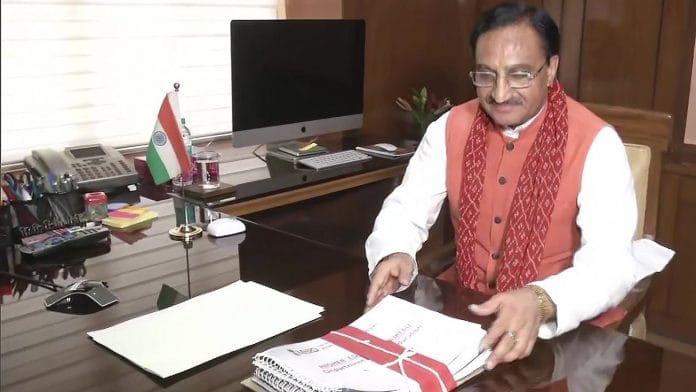New Delhi: Developing Sanskrit-speaking villages is among the first set of priorities of new Human Resource Development Minister Ramesh Pokhriyal ‘Nishank’ and two such villages could be near Delhi.
The villages will be located near Sanskrit-teaching institutions and the ministry will enlist tutors to teach the language to villagers or people living in the vicinity.
There are three Central government-run Sanskrit universities in India, including two in Delhi itself. The Rashtriya Sanskrit Sansthan and Shri Lal Bahadur Shastri Rashtriya Sanskrit Vidyapeeth are located in Delhi while the Rashtriya Sanskrit Vidyapeeth is in Tirupati, Andhra Pradesh.
The ministry is yet to finalise names of the villages but it has started working on a plan with the heads of the Sanskrit universities.
“The idea is that teachers from Sanskrit institutions will teach the language to people in a village or the vicinity by taking classes. This is being done for promotion of the ancient language. We are already in talks with the institutions and will soon start work on a plan,” said a senior official in the Ministry of Human Resource Development.
Pokhriyal, when he was chief minister of Uttarakhand, had adopted the Sanskrit-speaking Bhantola village in the state. Residents of Bhantola use both Hindi and Sanskrit to communicate with each other.
Apart from Bhantola, there are at least seven other villages in India where people use Sanskrit as a language of communication.
Pokhriyal had pitched the idea of developing Sanskrit-speaking villages in his first meeting with the language department of the ministry. He had emphasised that highly qualified teachers should be engaged in Sanskrit institutions and research should be encouraged to promote the language.
Pokhriyal also plans to have a ‘Bhasha Bhawan’ in the coming years – a building in which all Indian language institutes will have an office.
Also read: HRD minister ‘Nishank’ has written 44 books — high on patriotism, ‘low on literary value’
Sanskrit as part of curriculum
Sanskrit is currently being taught in many states from Class 1 to 12 at the school level. Kerala, for example, has Sanskrit as one of its languages from Class 1, Uttarakhand offers the language from Class 3 onward.
Many state boards also offer Sanskrit as part of its three-language formula, from Class 6 to 10, and as a second optional language in Class 11 and 12. The language is offered at both undergraduate and postgraduate level in colleges and universities too. About 120 universities offer Sanskrit at the UG and PG levels. There are 15 Sanskrit universities, including three that are run by the central government.
According to a report of the HRD ministry, an estimated five crore students study Sanskrit at school level. Close to 10 lakh students study the language in higher levels of education.
Also read: Here’s the 50-year-old three-language formula at heart of New Education Policy row







Hindi is Islamic origin and Pakistani language. This itself proves BJP as a radical Islamic party.
Clearly the Islamist HRD minister Pokiryal and Islamist party BJP are trying to convert India into an Islamic State which is why the prioritise that Islamic invaders language Hindi.
Clearly Islamic taqiyya at its best.
Hindi is a re
This is very good step to protect the tradion and propagation of Indian languages through Sanskrit. So many doesn’t know what is Sanskrit but opposing this language. It is one fashion. I support ministry. Thanks for good step.
No harm in according respect to the Sanskrit language. However, unclear if such projects should be on the priority list of the HRD ministry. The mission for India should be to restore the natural symmetry between academics and excellence that prevails all over the world. Of having more Indian entities in the list of the world’s top 100 and 500 institutions, encouraging a few top global universities to set up campuses in India. More young people from SAARC nations coming to India for higher education. At the base of the pyramid, improving learning outcomes in government schools, making children more proficient in English, using computers. Making HRD the focus of ideology, sending people of modest attainments to head important institutions like JNU, difficult to be sanguine about the future of education in India. We are setting the mould for underachievement as a nation.
I voted for this government but it is sad to look at the priorities of this government. In a world where development and employment is just a function of education and skills, our government’s sincerity is visible in the choice of HRD minister and his choices.
Why look at it as a priority? This does not mean HRD is doing nothing else. It is also a issue government is dealing with. If Jews can use Hebrew as national language, why Sanskrit cannot be one of the languages?
Hindi is a regional language spoken and used for official business in eight states , less before bifurcation of Bihar ,MP and Punjab ,lacks lucidity and international stature of English .With globalisation , integration of industry(our country being among top ten industralised nations in the world and further climbing ladder ) and services , there is further need to spread English in the country . Colloquial Hindi is spreading due to Bollywood .Even people in various spheres of Hindi language related professions prefer sending their wards for English medium school and college education . Use of Sanskratised words for naming various Central and State Govt. Schemes is another way by which govts.are trying to push Hindi even in non-Hindi speaking areas . Both Hindi and English languages are responsible for death of some ancient and native languages like Bo spoken by Great Andamanese .
Razor sharp conclusions .
Razor sharp conclusions .